Case Study Assignment: Negligence, Strict Liability, and Occupiers
VerifiedAdded on 2022/11/19
|25
|7032
|475
Case Study
AI Summary
This case study assignment analyzes three scenarios involving legal liability. The first case examines negligence, focusing on whether Simon Slater can claim against Lauren Lafarge for injuries due to a drain cover. It references Purtill v Athone UDC and McNamara v ESB to establish the duty of care and the potential for contributory negligence. The second case explores strict liability, specifically whether Charleston Confetti can claim damages against Lafarge for fire damage. It applies the principles of Rylands v Fletcher and Jones v Festiniog Railway Co., emphasizing the liability for dangerous substances and the precautions required. The final case assesses occupiers liability between Colin Cowdray and Lafarge Investment, referencing Roles v Nathan and Imperial Chemicals Industries Ltd v Shatwell to determine the responsibility of the occupier and the impact of warnings and employee actions. The assignment provides a detailed analysis of each case, applying relevant legal principles and case law to determine liability and provide recommendations.
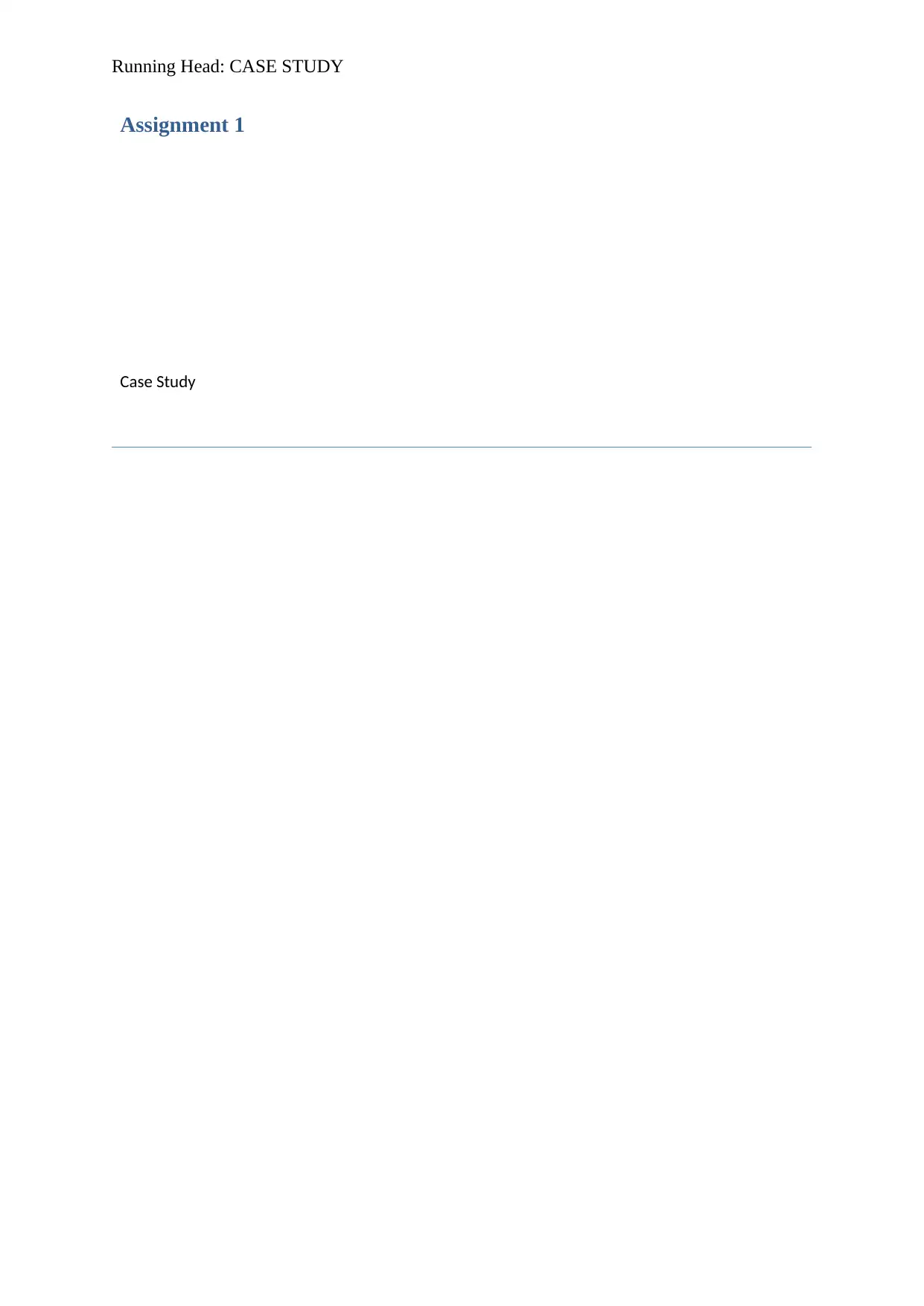
Running Head: CASE STUDY
Assignment 1
Case Study
Assignment 1
Case Study
Paraphrase This Document
Need a fresh take? Get an instant paraphrase of this document with our AI Paraphraser
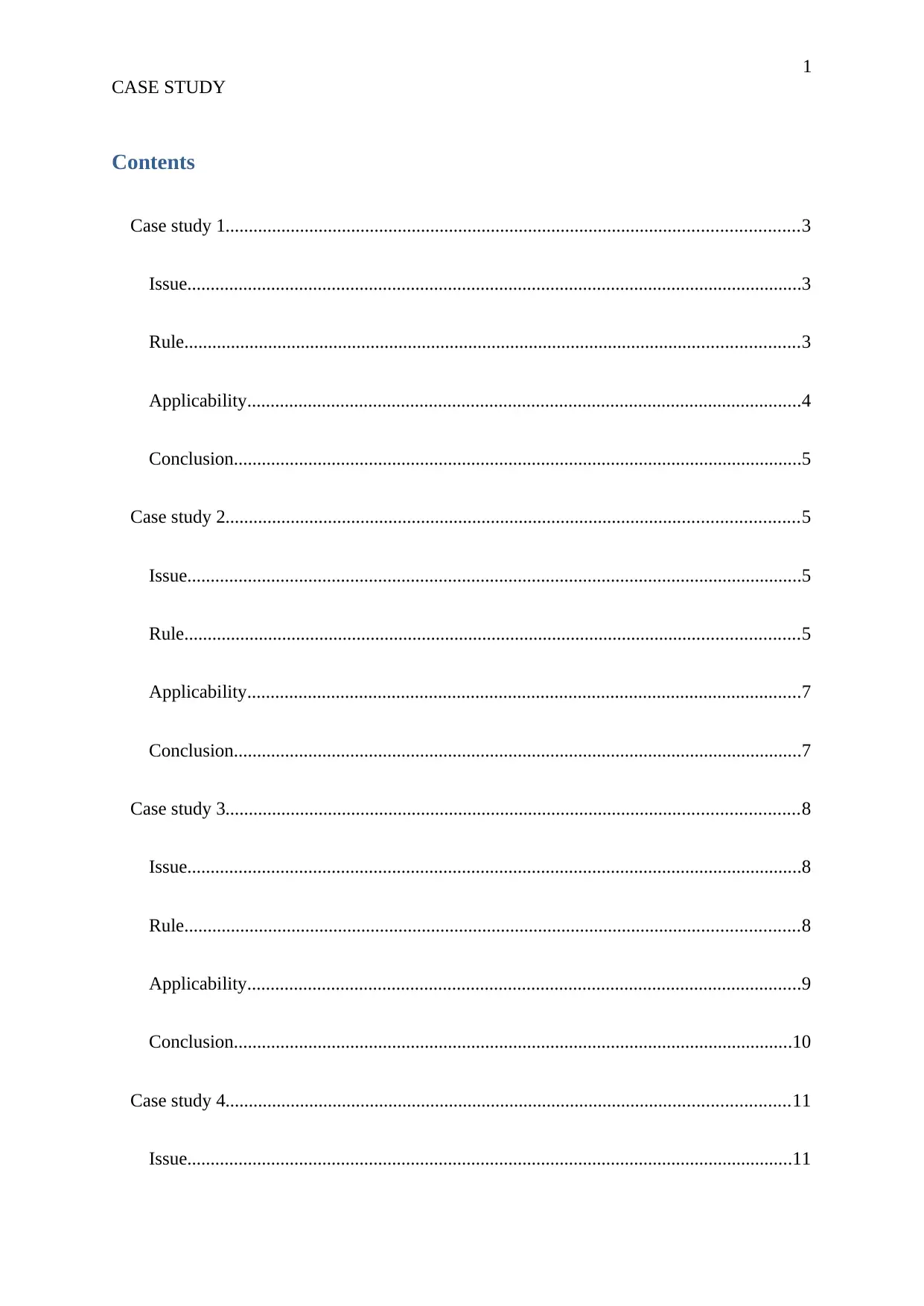
1
CASE STUDY
Contents
Case study 1...........................................................................................................................3
Issue....................................................................................................................................3
Rule....................................................................................................................................3
Applicability.......................................................................................................................4
Conclusion..........................................................................................................................5
Case study 2...........................................................................................................................5
Issue....................................................................................................................................5
Rule....................................................................................................................................5
Applicability.......................................................................................................................7
Conclusion..........................................................................................................................7
Case study 3...........................................................................................................................8
Issue....................................................................................................................................8
Rule....................................................................................................................................8
Applicability.......................................................................................................................9
Conclusion........................................................................................................................10
Case study 4.........................................................................................................................11
Issue..................................................................................................................................11
CASE STUDY
Contents
Case study 1...........................................................................................................................3
Issue....................................................................................................................................3
Rule....................................................................................................................................3
Applicability.......................................................................................................................4
Conclusion..........................................................................................................................5
Case study 2...........................................................................................................................5
Issue....................................................................................................................................5
Rule....................................................................................................................................5
Applicability.......................................................................................................................7
Conclusion..........................................................................................................................7
Case study 3...........................................................................................................................8
Issue....................................................................................................................................8
Rule....................................................................................................................................8
Applicability.......................................................................................................................9
Conclusion........................................................................................................................10
Case study 4.........................................................................................................................11
Issue..................................................................................................................................11
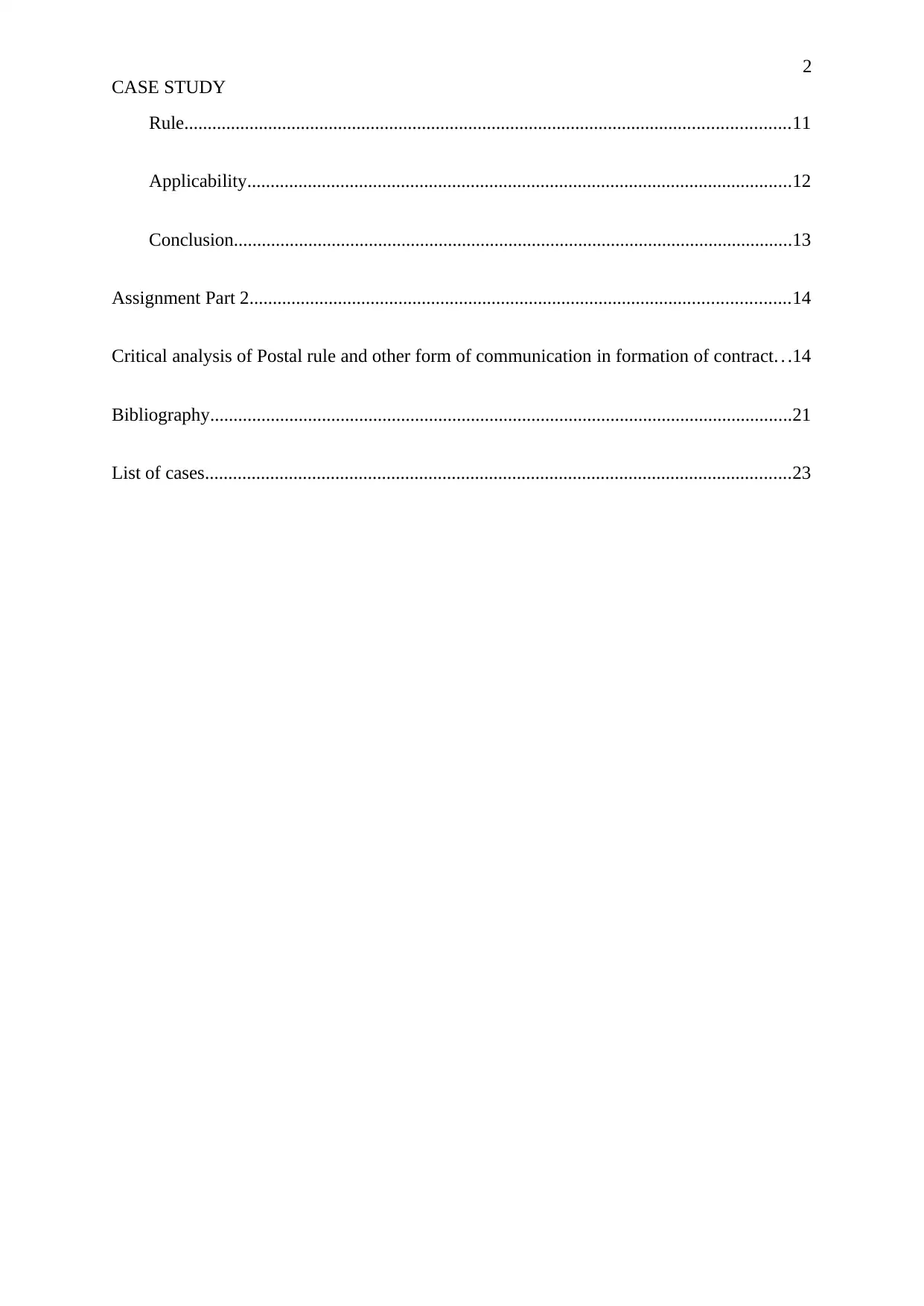
2
CASE STUDY
Rule..................................................................................................................................11
Applicability.....................................................................................................................12
Conclusion........................................................................................................................13
Assignment Part 2....................................................................................................................14
Critical analysis of Postal rule and other form of communication in formation of contract. . .14
Bibliography.............................................................................................................................21
List of cases..............................................................................................................................23
CASE STUDY
Rule..................................................................................................................................11
Applicability.....................................................................................................................12
Conclusion........................................................................................................................13
Assignment Part 2....................................................................................................................14
Critical analysis of Postal rule and other form of communication in formation of contract. . .14
Bibliography.............................................................................................................................21
List of cases..............................................................................................................................23
⊘ This is a preview!⊘
Do you want full access?
Subscribe today to unlock all pages.

Trusted by 1+ million students worldwide
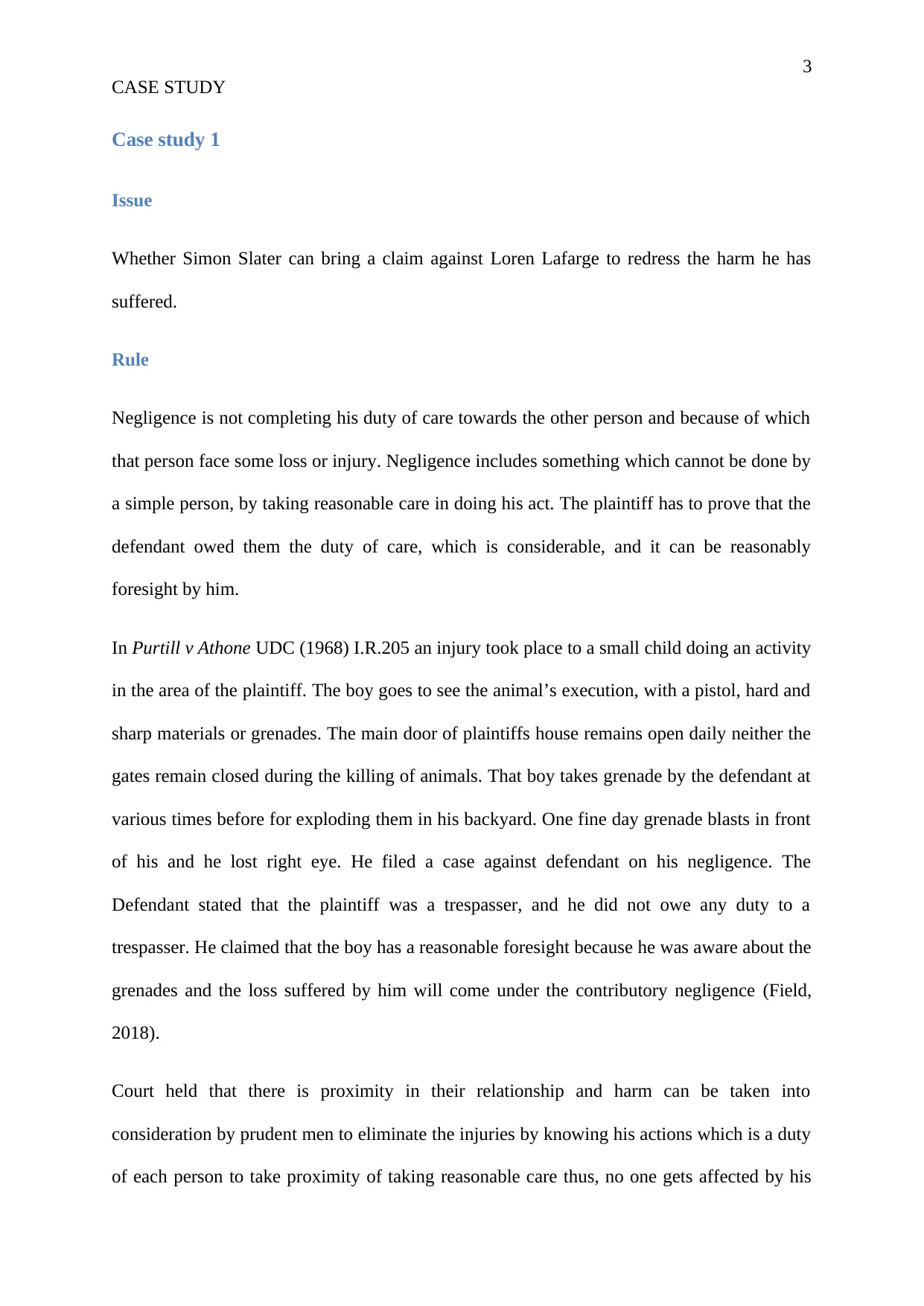
3
CASE STUDY
Case study 1
Issue
Whether Simon Slater can bring a claim against Loren Lafarge to redress the harm he has
suffered.
Rule
Negligence is not completing his duty of care towards the other person and because of which
that person face some loss or injury. Negligence includes something which cannot be done by
a simple person, by taking reasonable care in doing his act. The plaintiff has to prove that the
defendant owed them the duty of care, which is considerable, and it can be reasonably
foresight by him.
In Purtill v Athone UDC (1968) I.R.205 an injury took place to a small child doing an activity
in the area of the plaintiff. The boy goes to see the animal’s execution, with a pistol, hard and
sharp materials or grenades. The main door of plaintiffs house remains open daily neither the
gates remain closed during the killing of animals. That boy takes grenade by the defendant at
various times before for exploding them in his backyard. One fine day grenade blasts in front
of his and he lost right eye. He filed a case against defendant on his negligence. The
Defendant stated that the plaintiff was a trespasser, and he did not owe any duty to a
trespasser. He claimed that the boy has a reasonable foresight because he was aware about the
grenades and the loss suffered by him will come under the contributory negligence (Field,
2018).
Court held that there is proximity in their relationship and harm can be taken into
consideration by prudent men to eliminate the injuries by knowing his actions which is a duty
of each person to take proximity of taking reasonable care thus, no one gets affected by his
CASE STUDY
Case study 1
Issue
Whether Simon Slater can bring a claim against Loren Lafarge to redress the harm he has
suffered.
Rule
Negligence is not completing his duty of care towards the other person and because of which
that person face some loss or injury. Negligence includes something which cannot be done by
a simple person, by taking reasonable care in doing his act. The plaintiff has to prove that the
defendant owed them the duty of care, which is considerable, and it can be reasonably
foresight by him.
In Purtill v Athone UDC (1968) I.R.205 an injury took place to a small child doing an activity
in the area of the plaintiff. The boy goes to see the animal’s execution, with a pistol, hard and
sharp materials or grenades. The main door of plaintiffs house remains open daily neither the
gates remain closed during the killing of animals. That boy takes grenade by the defendant at
various times before for exploding them in his backyard. One fine day grenade blasts in front
of his and he lost right eye. He filed a case against defendant on his negligence. The
Defendant stated that the plaintiff was a trespasser, and he did not owe any duty to a
trespasser. He claimed that the boy has a reasonable foresight because he was aware about the
grenades and the loss suffered by him will come under the contributory negligence (Field,
2018).
Court held that there is proximity in their relationship and harm can be taken into
consideration by prudent men to eliminate the injuries by knowing his actions which is a duty
of each person to take proximity of taking reasonable care thus, no one gets affected by his
Paraphrase This Document
Need a fresh take? Get an instant paraphrase of this document with our AI Paraphraser
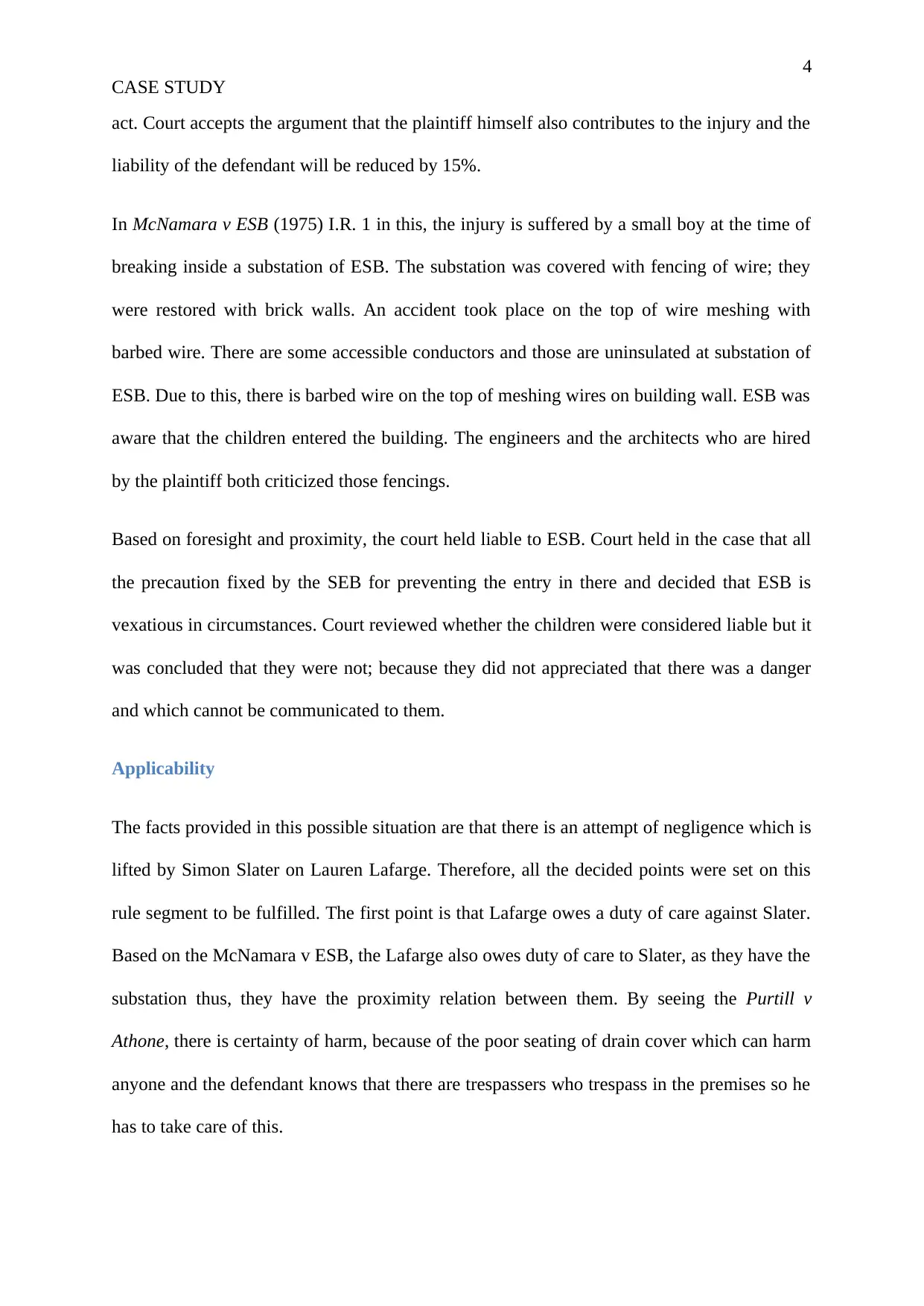
4
CASE STUDY
act. Court accepts the argument that the plaintiff himself also contributes to the injury and the
liability of the defendant will be reduced by 15%.
In McNamara v ESB (1975) I.R. 1 in this, the injury is suffered by a small boy at the time of
breaking inside a substation of ESB. The substation was covered with fencing of wire; they
were restored with brick walls. An accident took place on the top of wire meshing with
barbed wire. There are some accessible conductors and those are uninsulated at substation of
ESB. Due to this, there is barbed wire on the top of meshing wires on building wall. ESB was
aware that the children entered the building. The engineers and the architects who are hired
by the plaintiff both criticized those fencings.
Based on foresight and proximity, the court held liable to ESB. Court held in the case that all
the precaution fixed by the SEB for preventing the entry in there and decided that ESB is
vexatious in circumstances. Court reviewed whether the children were considered liable but it
was concluded that they were not; because they did not appreciated that there was a danger
and which cannot be communicated to them.
Applicability
The facts provided in this possible situation are that there is an attempt of negligence which is
lifted by Simon Slater on Lauren Lafarge. Therefore, all the decided points were set on this
rule segment to be fulfilled. The first point is that Lafarge owes a duty of care against Slater.
Based on the McNamara v ESB, the Lafarge also owes duty of care to Slater, as they have the
substation thus, they have the proximity relation between them. By seeing the Purtill v
Athone, there is certainty of harm, because of the poor seating of drain cover which can harm
anyone and the defendant knows that there are trespassers who trespass in the premises so he
has to take care of this.
CASE STUDY
act. Court accepts the argument that the plaintiff himself also contributes to the injury and the
liability of the defendant will be reduced by 15%.
In McNamara v ESB (1975) I.R. 1 in this, the injury is suffered by a small boy at the time of
breaking inside a substation of ESB. The substation was covered with fencing of wire; they
were restored with brick walls. An accident took place on the top of wire meshing with
barbed wire. There are some accessible conductors and those are uninsulated at substation of
ESB. Due to this, there is barbed wire on the top of meshing wires on building wall. ESB was
aware that the children entered the building. The engineers and the architects who are hired
by the plaintiff both criticized those fencings.
Based on foresight and proximity, the court held liable to ESB. Court held in the case that all
the precaution fixed by the SEB for preventing the entry in there and decided that ESB is
vexatious in circumstances. Court reviewed whether the children were considered liable but it
was concluded that they were not; because they did not appreciated that there was a danger
and which cannot be communicated to them.
Applicability
The facts provided in this possible situation are that there is an attempt of negligence which is
lifted by Simon Slater on Lauren Lafarge. Therefore, all the decided points were set on this
rule segment to be fulfilled. The first point is that Lafarge owes a duty of care against Slater.
Based on the McNamara v ESB, the Lafarge also owes duty of care to Slater, as they have the
substation thus, they have the proximity relation between them. By seeing the Purtill v
Athone, there is certainty of harm, because of the poor seating of drain cover which can harm
anyone and the defendant knows that there are trespassers who trespass in the premises so he
has to take care of this.
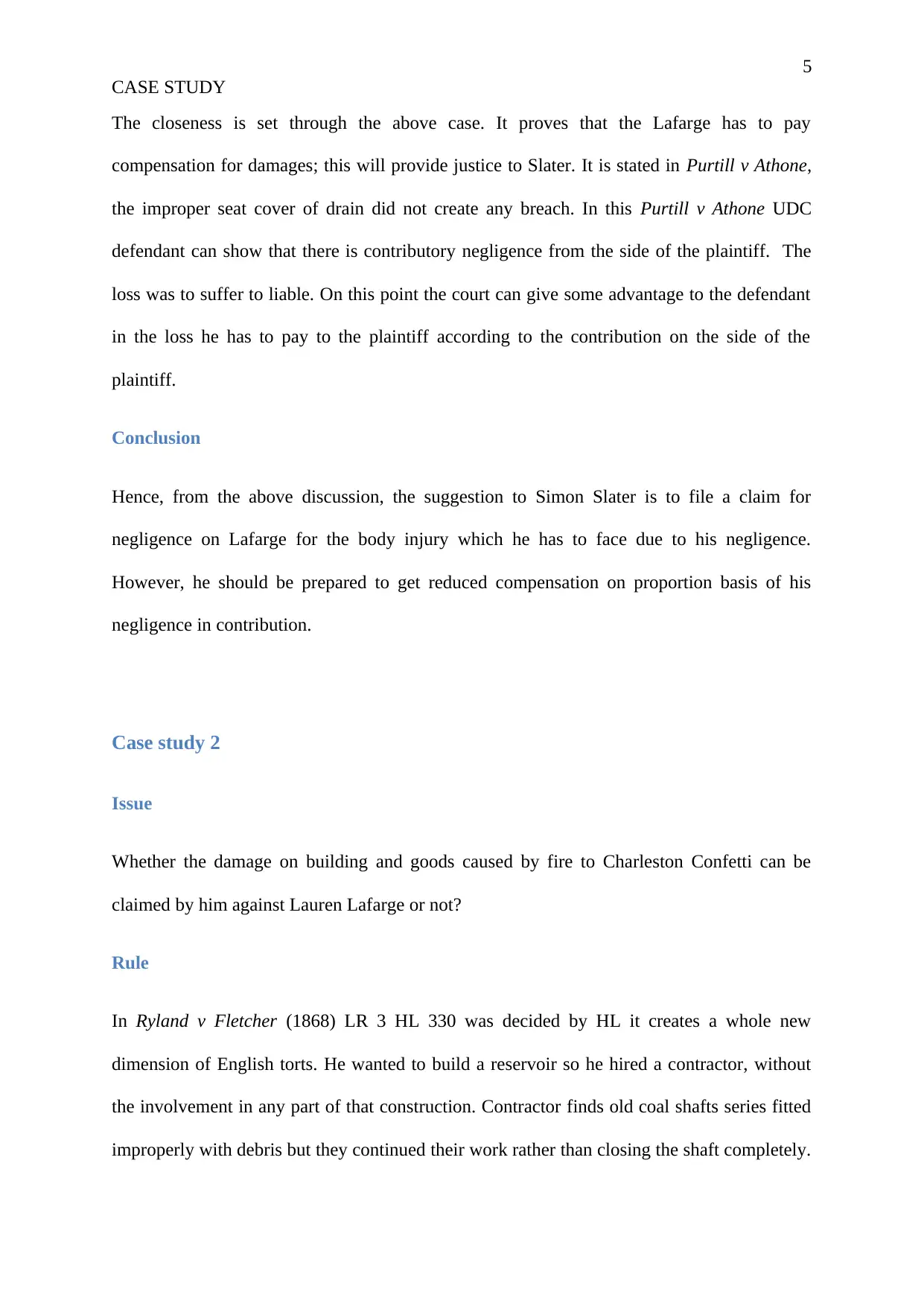
5
CASE STUDY
The closeness is set through the above case. It proves that the Lafarge has to pay
compensation for damages; this will provide justice to Slater. It is stated in Purtill v Athone,
the improper seat cover of drain did not create any breach. In this Purtill v Athone UDC
defendant can show that there is contributory negligence from the side of the plaintiff. The
loss was to suffer to liable. On this point the court can give some advantage to the defendant
in the loss he has to pay to the plaintiff according to the contribution on the side of the
plaintiff.
Conclusion
Hence, from the above discussion, the suggestion to Simon Slater is to file a claim for
negligence on Lafarge for the body injury which he has to face due to his negligence.
However, he should be prepared to get reduced compensation on proportion basis of his
negligence in contribution.
Case study 2
Issue
Whether the damage on building and goods caused by fire to Charleston Confetti can be
claimed by him against Lauren Lafarge or not?
Rule
In Ryland v Fletcher (1868) LR 3 HL 330 was decided by HL it creates a whole new
dimension of English torts. He wanted to build a reservoir so he hired a contractor, without
the involvement in any part of that construction. Contractor finds old coal shafts series fitted
improperly with debris but they continued their work rather than closing the shaft completely.
CASE STUDY
The closeness is set through the above case. It proves that the Lafarge has to pay
compensation for damages; this will provide justice to Slater. It is stated in Purtill v Athone,
the improper seat cover of drain did not create any breach. In this Purtill v Athone UDC
defendant can show that there is contributory negligence from the side of the plaintiff. The
loss was to suffer to liable. On this point the court can give some advantage to the defendant
in the loss he has to pay to the plaintiff according to the contribution on the side of the
plaintiff.
Conclusion
Hence, from the above discussion, the suggestion to Simon Slater is to file a claim for
negligence on Lafarge for the body injury which he has to face due to his negligence.
However, he should be prepared to get reduced compensation on proportion basis of his
negligence in contribution.
Case study 2
Issue
Whether the damage on building and goods caused by fire to Charleston Confetti can be
claimed by him against Lauren Lafarge or not?
Rule
In Ryland v Fletcher (1868) LR 3 HL 330 was decided by HL it creates a whole new
dimension of English torts. He wanted to build a reservoir so he hired a contractor, without
the involvement in any part of that construction. Contractor finds old coal shafts series fitted
improperly with debris but they continued their work rather than closing the shaft completely.
⊘ This is a preview!⊘
Do you want full access?
Subscribe today to unlock all pages.

Trusted by 1+ million students worldwide
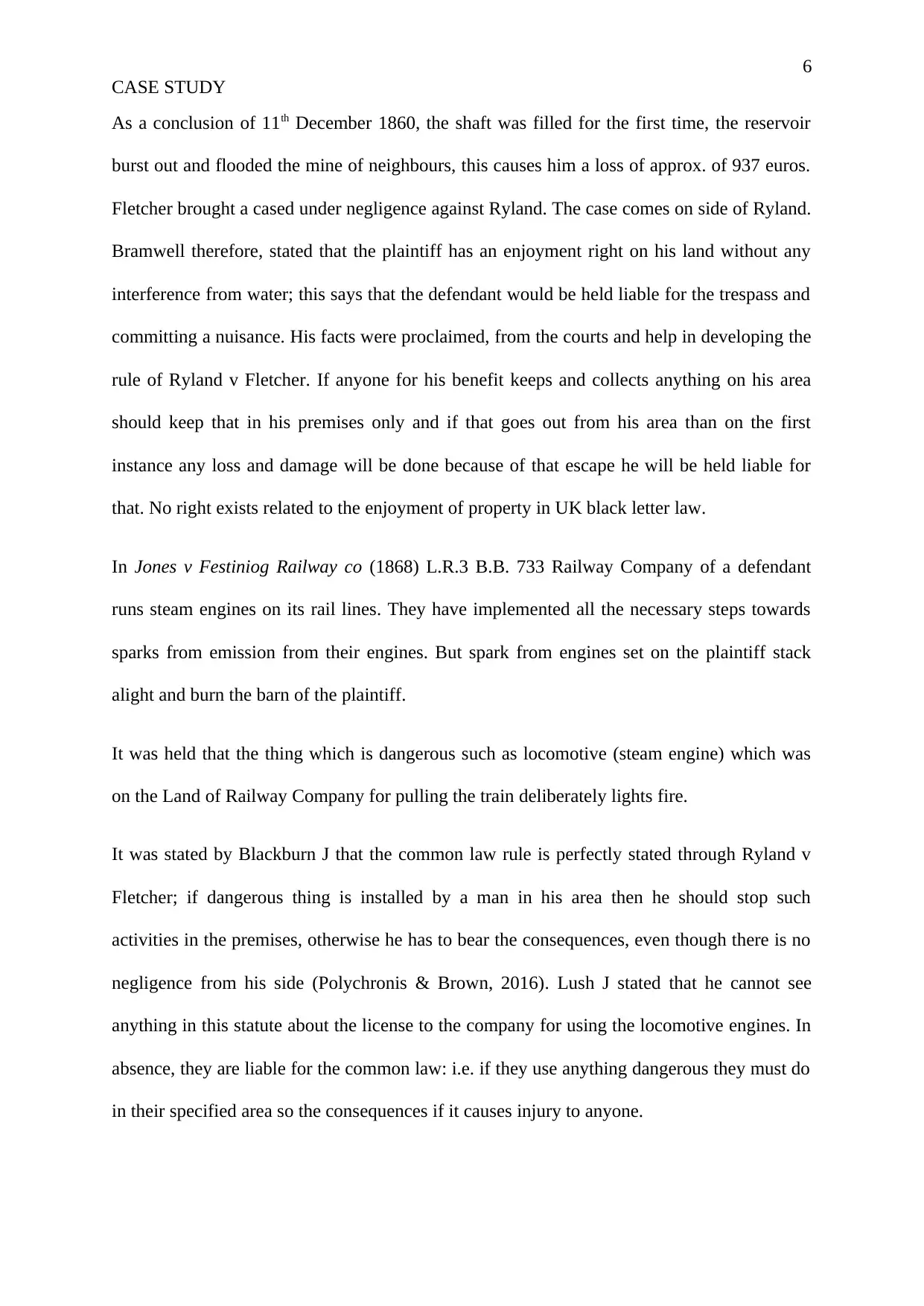
6
CASE STUDY
As a conclusion of 11th December 1860, the shaft was filled for the first time, the reservoir
burst out and flooded the mine of neighbours, this causes him a loss of approx. of 937 euros.
Fletcher brought a cased under negligence against Ryland. The case comes on side of Ryland.
Bramwell therefore, stated that the plaintiff has an enjoyment right on his land without any
interference from water; this says that the defendant would be held liable for the trespass and
committing a nuisance. His facts were proclaimed, from the courts and help in developing the
rule of Ryland v Fletcher. If anyone for his benefit keeps and collects anything on his area
should keep that in his premises only and if that goes out from his area than on the first
instance any loss and damage will be done because of that escape he will be held liable for
that. No right exists related to the enjoyment of property in UK black letter law.
In Jones v Festiniog Railway co (1868) L.R.3 B.B. 733 Railway Company of a defendant
runs steam engines on its rail lines. They have implemented all the necessary steps towards
sparks from emission from their engines. But spark from engines set on the plaintiff stack
alight and burn the barn of the plaintiff.
It was held that the thing which is dangerous such as locomotive (steam engine) which was
on the Land of Railway Company for pulling the train deliberately lights fire.
It was stated by Blackburn J that the common law rule is perfectly stated through Ryland v
Fletcher; if dangerous thing is installed by a man in his area then he should stop such
activities in the premises, otherwise he has to bear the consequences, even though there is no
negligence from his side (Polychronis & Brown, 2016). Lush J stated that he cannot see
anything in this statute about the license to the company for using the locomotive engines. In
absence, they are liable for the common law: i.e. if they use anything dangerous they must do
in their specified area so the consequences if it causes injury to anyone.
CASE STUDY
As a conclusion of 11th December 1860, the shaft was filled for the first time, the reservoir
burst out and flooded the mine of neighbours, this causes him a loss of approx. of 937 euros.
Fletcher brought a cased under negligence against Ryland. The case comes on side of Ryland.
Bramwell therefore, stated that the plaintiff has an enjoyment right on his land without any
interference from water; this says that the defendant would be held liable for the trespass and
committing a nuisance. His facts were proclaimed, from the courts and help in developing the
rule of Ryland v Fletcher. If anyone for his benefit keeps and collects anything on his area
should keep that in his premises only and if that goes out from his area than on the first
instance any loss and damage will be done because of that escape he will be held liable for
that. No right exists related to the enjoyment of property in UK black letter law.
In Jones v Festiniog Railway co (1868) L.R.3 B.B. 733 Railway Company of a defendant
runs steam engines on its rail lines. They have implemented all the necessary steps towards
sparks from emission from their engines. But spark from engines set on the plaintiff stack
alight and burn the barn of the plaintiff.
It was held that the thing which is dangerous such as locomotive (steam engine) which was
on the Land of Railway Company for pulling the train deliberately lights fire.
It was stated by Blackburn J that the common law rule is perfectly stated through Ryland v
Fletcher; if dangerous thing is installed by a man in his area then he should stop such
activities in the premises, otherwise he has to bear the consequences, even though there is no
negligence from his side (Polychronis & Brown, 2016). Lush J stated that he cannot see
anything in this statute about the license to the company for using the locomotive engines. In
absence, they are liable for the common law: i.e. if they use anything dangerous they must do
in their specified area so the consequences if it causes injury to anyone.
Paraphrase This Document
Need a fresh take? Get an instant paraphrase of this document with our AI Paraphraser
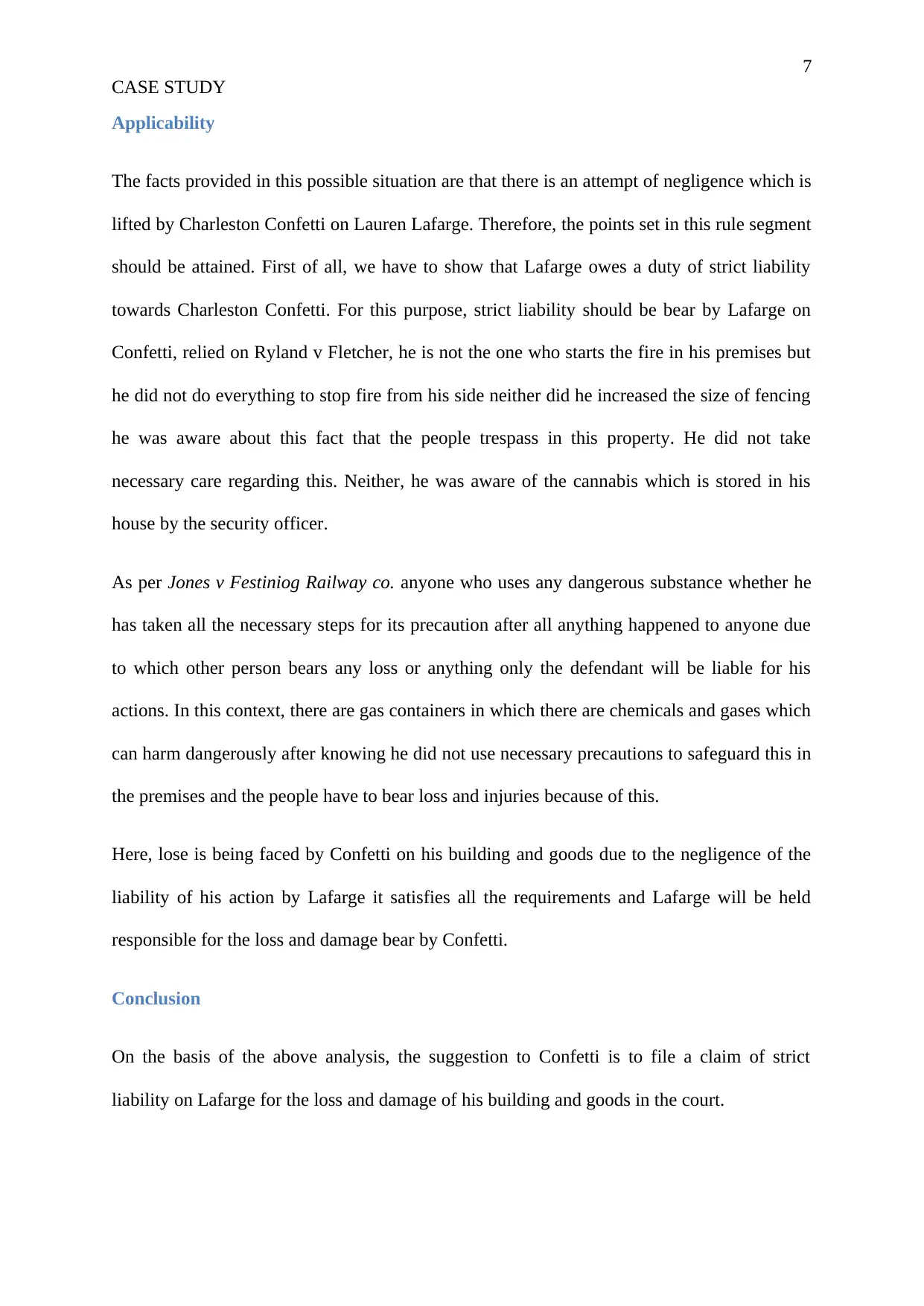
7
CASE STUDY
Applicability
The facts provided in this possible situation are that there is an attempt of negligence which is
lifted by Charleston Confetti on Lauren Lafarge. Therefore, the points set in this rule segment
should be attained. First of all, we have to show that Lafarge owes a duty of strict liability
towards Charleston Confetti. For this purpose, strict liability should be bear by Lafarge on
Confetti, relied on Ryland v Fletcher, he is not the one who starts the fire in his premises but
he did not do everything to stop fire from his side neither did he increased the size of fencing
he was aware about this fact that the people trespass in this property. He did not take
necessary care regarding this. Neither, he was aware of the cannabis which is stored in his
house by the security officer.
As per Jones v Festiniog Railway co. anyone who uses any dangerous substance whether he
has taken all the necessary steps for its precaution after all anything happened to anyone due
to which other person bears any loss or anything only the defendant will be liable for his
actions. In this context, there are gas containers in which there are chemicals and gases which
can harm dangerously after knowing he did not use necessary precautions to safeguard this in
the premises and the people have to bear loss and injuries because of this.
Here, lose is being faced by Confetti on his building and goods due to the negligence of the
liability of his action by Lafarge it satisfies all the requirements and Lafarge will be held
responsible for the loss and damage bear by Confetti.
Conclusion
On the basis of the above analysis, the suggestion to Confetti is to file a claim of strict
liability on Lafarge for the loss and damage of his building and goods in the court.
CASE STUDY
Applicability
The facts provided in this possible situation are that there is an attempt of negligence which is
lifted by Charleston Confetti on Lauren Lafarge. Therefore, the points set in this rule segment
should be attained. First of all, we have to show that Lafarge owes a duty of strict liability
towards Charleston Confetti. For this purpose, strict liability should be bear by Lafarge on
Confetti, relied on Ryland v Fletcher, he is not the one who starts the fire in his premises but
he did not do everything to stop fire from his side neither did he increased the size of fencing
he was aware about this fact that the people trespass in this property. He did not take
necessary care regarding this. Neither, he was aware of the cannabis which is stored in his
house by the security officer.
As per Jones v Festiniog Railway co. anyone who uses any dangerous substance whether he
has taken all the necessary steps for its precaution after all anything happened to anyone due
to which other person bears any loss or anything only the defendant will be liable for his
actions. In this context, there are gas containers in which there are chemicals and gases which
can harm dangerously after knowing he did not use necessary precautions to safeguard this in
the premises and the people have to bear loss and injuries because of this.
Here, lose is being faced by Confetti on his building and goods due to the negligence of the
liability of his action by Lafarge it satisfies all the requirements and Lafarge will be held
responsible for the loss and damage bear by Confetti.
Conclusion
On the basis of the above analysis, the suggestion to Confetti is to file a claim of strict
liability on Lafarge for the loss and damage of his building and goods in the court.
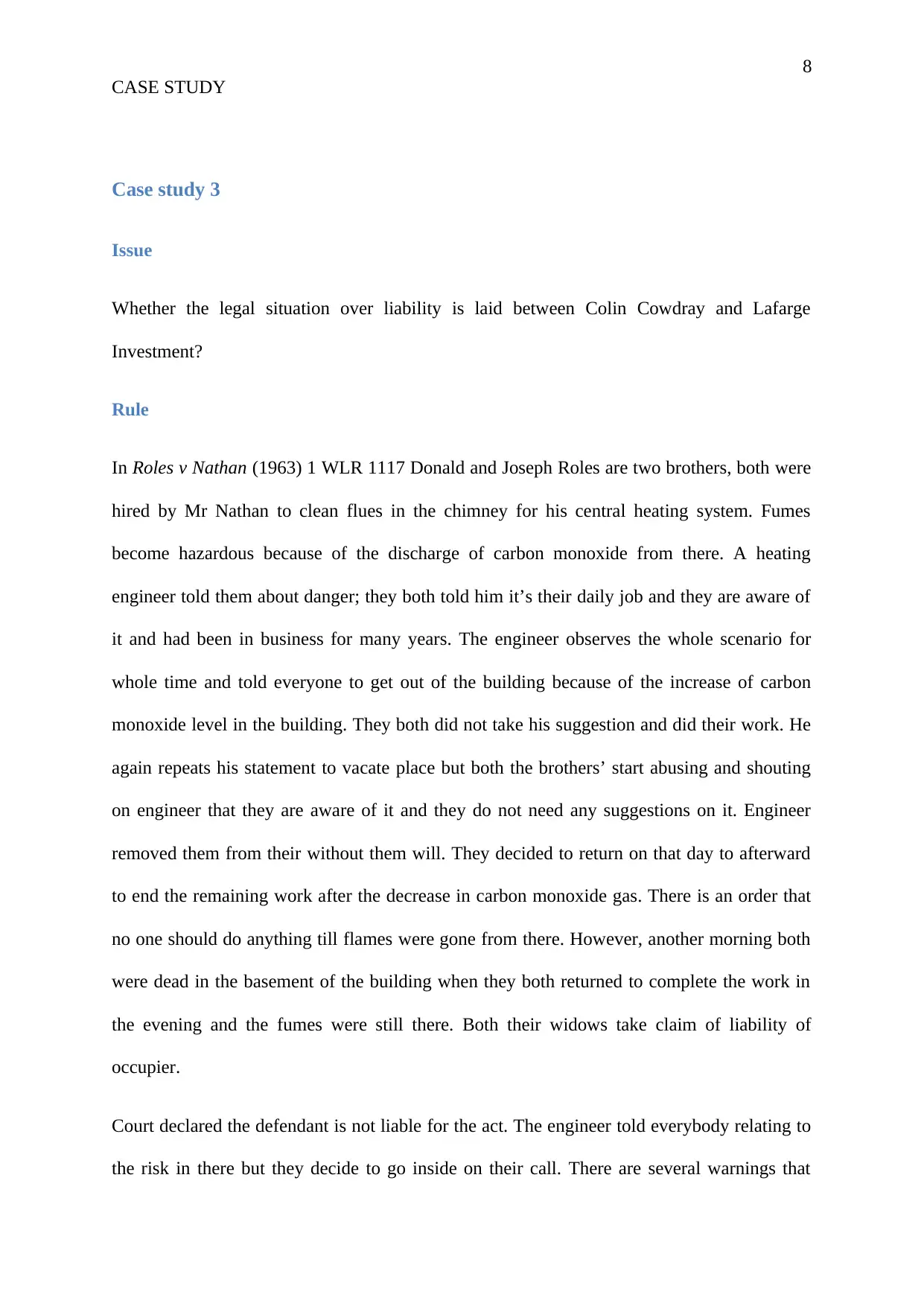
8
CASE STUDY
Case study 3
Issue
Whether the legal situation over liability is laid between Colin Cowdray and Lafarge
Investment?
Rule
In Roles v Nathan (1963) 1 WLR 1117 Donald and Joseph Roles are two brothers, both were
hired by Mr Nathan to clean flues in the chimney for his central heating system. Fumes
become hazardous because of the discharge of carbon monoxide from there. A heating
engineer told them about danger; they both told him it’s their daily job and they are aware of
it and had been in business for many years. The engineer observes the whole scenario for
whole time and told everyone to get out of the building because of the increase of carbon
monoxide level in the building. They both did not take his suggestion and did their work. He
again repeats his statement to vacate place but both the brothers’ start abusing and shouting
on engineer that they are aware of it and they do not need any suggestions on it. Engineer
removed them from their without them will. They decided to return on that day to afterward
to end the remaining work after the decrease in carbon monoxide gas. There is an order that
no one should do anything till flames were gone from there. However, another morning both
were dead in the basement of the building when they both returned to complete the work in
the evening and the fumes were still there. Both their widows take claim of liability of
occupier.
Court declared the defendant is not liable for the act. The engineer told everybody relating to
the risk in there but they decide to go inside on their call. There are several warnings that
CASE STUDY
Case study 3
Issue
Whether the legal situation over liability is laid between Colin Cowdray and Lafarge
Investment?
Rule
In Roles v Nathan (1963) 1 WLR 1117 Donald and Joseph Roles are two brothers, both were
hired by Mr Nathan to clean flues in the chimney for his central heating system. Fumes
become hazardous because of the discharge of carbon monoxide from there. A heating
engineer told them about danger; they both told him it’s their daily job and they are aware of
it and had been in business for many years. The engineer observes the whole scenario for
whole time and told everyone to get out of the building because of the increase of carbon
monoxide level in the building. They both did not take his suggestion and did their work. He
again repeats his statement to vacate place but both the brothers’ start abusing and shouting
on engineer that they are aware of it and they do not need any suggestions on it. Engineer
removed them from their without them will. They decided to return on that day to afterward
to end the remaining work after the decrease in carbon monoxide gas. There is an order that
no one should do anything till flames were gone from there. However, another morning both
were dead in the basement of the building when they both returned to complete the work in
the evening and the fumes were still there. Both their widows take claim of liability of
occupier.
Court declared the defendant is not liable for the act. The engineer told everybody relating to
the risk in there but they decide to go inside on their call. There are several warnings that
⊘ This is a preview!⊘
Do you want full access?
Subscribe today to unlock all pages.

Trusted by 1+ million students worldwide
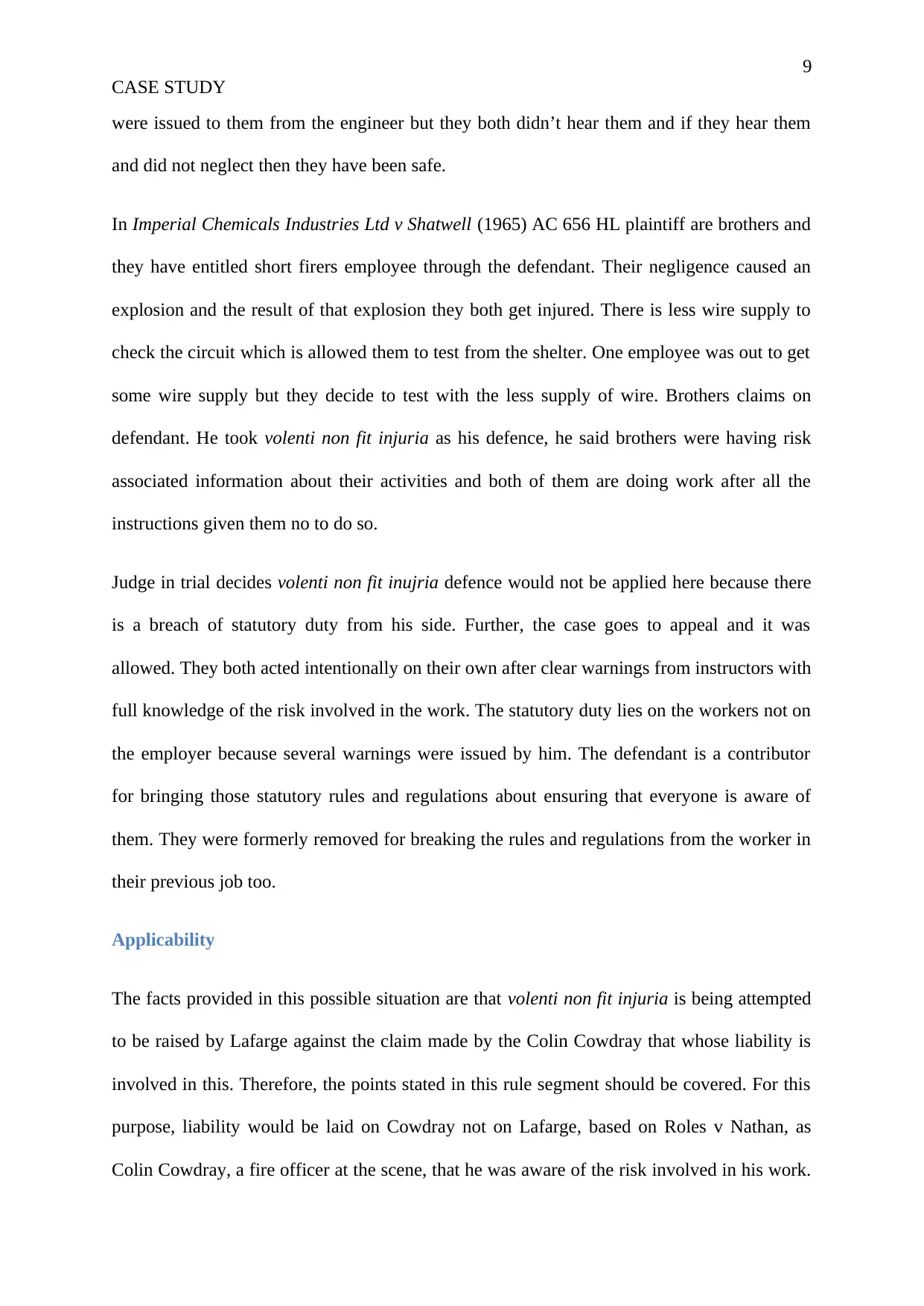
9
CASE STUDY
were issued to them from the engineer but they both didn’t hear them and if they hear them
and did not neglect then they have been safe.
In Imperial Chemicals Industries Ltd v Shatwell (1965) AC 656 HL plaintiff are brothers and
they have entitled short firers employee through the defendant. Their negligence caused an
explosion and the result of that explosion they both get injured. There is less wire supply to
check the circuit which is allowed them to test from the shelter. One employee was out to get
some wire supply but they decide to test with the less supply of wire. Brothers claims on
defendant. He took volenti non fit injuria as his defence, he said brothers were having risk
associated information about their activities and both of them are doing work after all the
instructions given them no to do so.
Judge in trial decides volenti non fit inujria defence would not be applied here because there
is a breach of statutory duty from his side. Further, the case goes to appeal and it was
allowed. They both acted intentionally on their own after clear warnings from instructors with
full knowledge of the risk involved in the work. The statutory duty lies on the workers not on
the employer because several warnings were issued by him. The defendant is a contributor
for bringing those statutory rules and regulations about ensuring that everyone is aware of
them. They were formerly removed for breaking the rules and regulations from the worker in
their previous job too.
Applicability
The facts provided in this possible situation are that volenti non fit injuria is being attempted
to be raised by Lafarge against the claim made by the Colin Cowdray that whose liability is
involved in this. Therefore, the points stated in this rule segment should be covered. For this
purpose, liability would be laid on Cowdray not on Lafarge, based on Roles v Nathan, as
Colin Cowdray, a fire officer at the scene, that he was aware of the risk involved in his work.
CASE STUDY
were issued to them from the engineer but they both didn’t hear them and if they hear them
and did not neglect then they have been safe.
In Imperial Chemicals Industries Ltd v Shatwell (1965) AC 656 HL plaintiff are brothers and
they have entitled short firers employee through the defendant. Their negligence caused an
explosion and the result of that explosion they both get injured. There is less wire supply to
check the circuit which is allowed them to test from the shelter. One employee was out to get
some wire supply but they decide to test with the less supply of wire. Brothers claims on
defendant. He took volenti non fit injuria as his defence, he said brothers were having risk
associated information about their activities and both of them are doing work after all the
instructions given them no to do so.
Judge in trial decides volenti non fit inujria defence would not be applied here because there
is a breach of statutory duty from his side. Further, the case goes to appeal and it was
allowed. They both acted intentionally on their own after clear warnings from instructors with
full knowledge of the risk involved in the work. The statutory duty lies on the workers not on
the employer because several warnings were issued by him. The defendant is a contributor
for bringing those statutory rules and regulations about ensuring that everyone is aware of
them. They were formerly removed for breaking the rules and regulations from the worker in
their previous job too.
Applicability
The facts provided in this possible situation are that volenti non fit injuria is being attempted
to be raised by Lafarge against the claim made by the Colin Cowdray that whose liability is
involved in this. Therefore, the points stated in this rule segment should be covered. For this
purpose, liability would be laid on Cowdray not on Lafarge, based on Roles v Nathan, as
Colin Cowdray, a fire officer at the scene, that he was aware of the risk involved in his work.
Paraphrase This Document
Need a fresh take? Get an instant paraphrase of this document with our AI Paraphraser
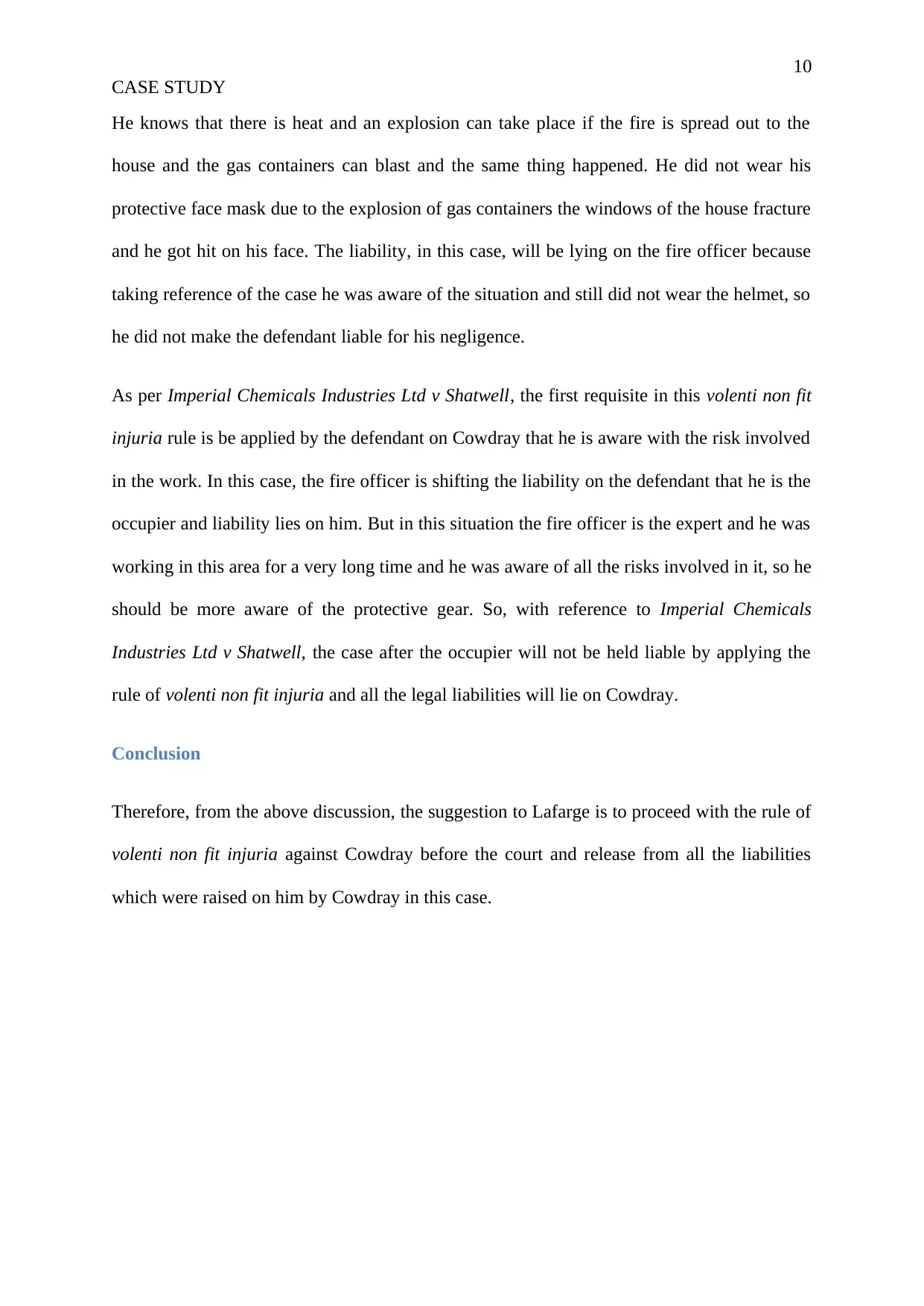
10
CASE STUDY
He knows that there is heat and an explosion can take place if the fire is spread out to the
house and the gas containers can blast and the same thing happened. He did not wear his
protective face mask due to the explosion of gas containers the windows of the house fracture
and he got hit on his face. The liability, in this case, will be lying on the fire officer because
taking reference of the case he was aware of the situation and still did not wear the helmet, so
he did not make the defendant liable for his negligence.
As per Imperial Chemicals Industries Ltd v Shatwell, the first requisite in this volenti non fit
injuria rule is be applied by the defendant on Cowdray that he is aware with the risk involved
in the work. In this case, the fire officer is shifting the liability on the defendant that he is the
occupier and liability lies on him. But in this situation the fire officer is the expert and he was
working in this area for a very long time and he was aware of all the risks involved in it, so he
should be more aware of the protective gear. So, with reference to Imperial Chemicals
Industries Ltd v Shatwell, the case after the occupier will not be held liable by applying the
rule of volenti non fit injuria and all the legal liabilities will lie on Cowdray.
Conclusion
Therefore, from the above discussion, the suggestion to Lafarge is to proceed with the rule of
volenti non fit injuria against Cowdray before the court and release from all the liabilities
which were raised on him by Cowdray in this case.
CASE STUDY
He knows that there is heat and an explosion can take place if the fire is spread out to the
house and the gas containers can blast and the same thing happened. He did not wear his
protective face mask due to the explosion of gas containers the windows of the house fracture
and he got hit on his face. The liability, in this case, will be lying on the fire officer because
taking reference of the case he was aware of the situation and still did not wear the helmet, so
he did not make the defendant liable for his negligence.
As per Imperial Chemicals Industries Ltd v Shatwell, the first requisite in this volenti non fit
injuria rule is be applied by the defendant on Cowdray that he is aware with the risk involved
in the work. In this case, the fire officer is shifting the liability on the defendant that he is the
occupier and liability lies on him. But in this situation the fire officer is the expert and he was
working in this area for a very long time and he was aware of all the risks involved in it, so he
should be more aware of the protective gear. So, with reference to Imperial Chemicals
Industries Ltd v Shatwell, the case after the occupier will not be held liable by applying the
rule of volenti non fit injuria and all the legal liabilities will lie on Cowdray.
Conclusion
Therefore, from the above discussion, the suggestion to Lafarge is to proceed with the rule of
volenti non fit injuria against Cowdray before the court and release from all the liabilities
which were raised on him by Cowdray in this case.
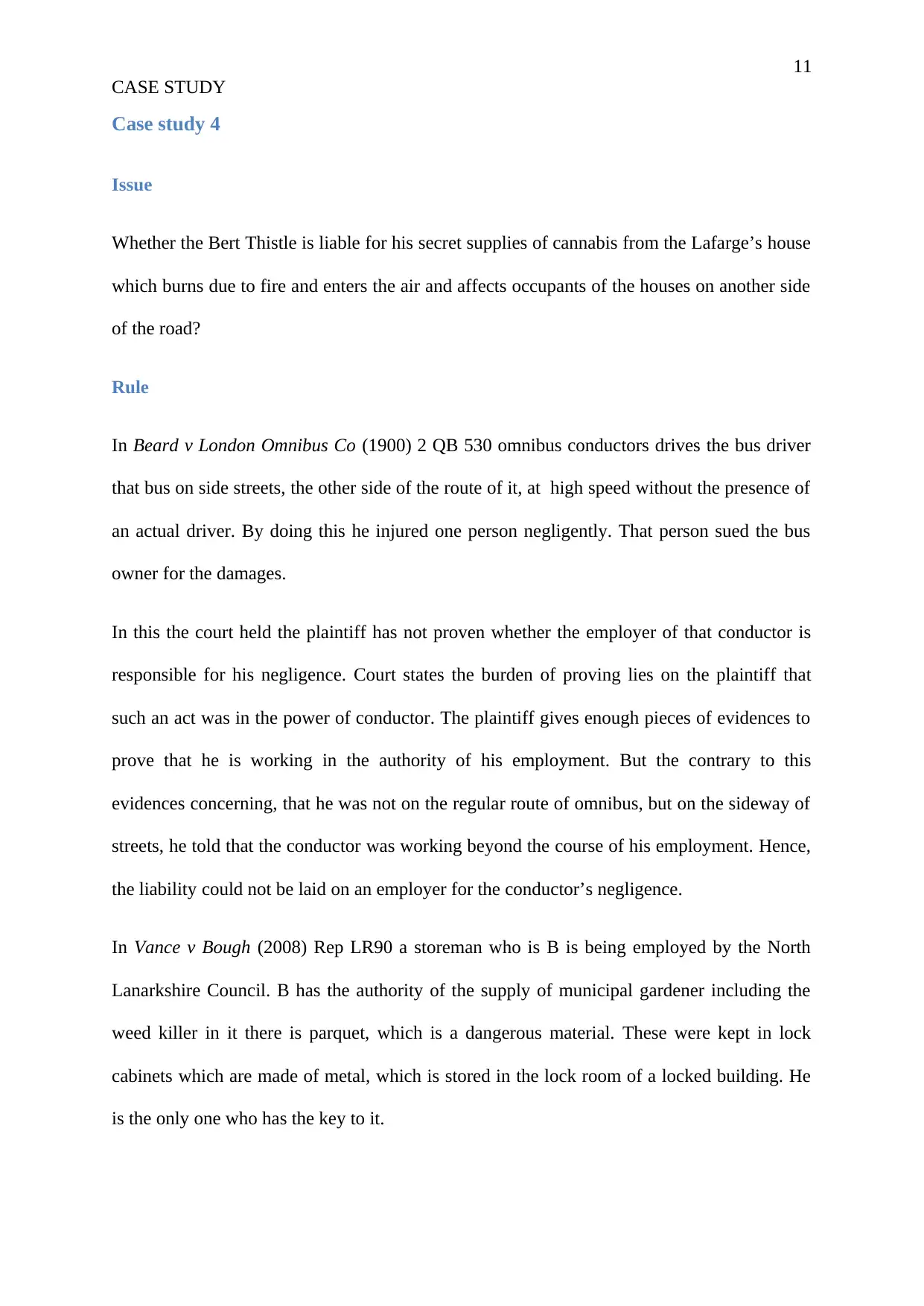
11
CASE STUDY
Case study 4
Issue
Whether the Bert Thistle is liable for his secret supplies of cannabis from the Lafarge’s house
which burns due to fire and enters the air and affects occupants of the houses on another side
of the road?
Rule
In Beard v London Omnibus Co (1900) 2 QB 530 omnibus conductors drives the bus driver
that bus on side streets, the other side of the route of it, at high speed without the presence of
an actual driver. By doing this he injured one person negligently. That person sued the bus
owner for the damages.
In this the court held the plaintiff has not proven whether the employer of that conductor is
responsible for his negligence. Court states the burden of proving lies on the plaintiff that
such an act was in the power of conductor. The plaintiff gives enough pieces of evidences to
prove that he is working in the authority of his employment. But the contrary to this
evidences concerning, that he was not on the regular route of omnibus, but on the sideway of
streets, he told that the conductor was working beyond the course of his employment. Hence,
the liability could not be laid on an employer for the conductor’s negligence.
In Vance v Bough (2008) Rep LR90 a storeman who is B is being employed by the North
Lanarkshire Council. B has the authority of the supply of municipal gardener including the
weed killer in it there is parquet, which is a dangerous material. These were kept in lock
cabinets which are made of metal, which is stored in the lock room of a locked building. He
is the only one who has the key to it.
CASE STUDY
Case study 4
Issue
Whether the Bert Thistle is liable for his secret supplies of cannabis from the Lafarge’s house
which burns due to fire and enters the air and affects occupants of the houses on another side
of the road?
Rule
In Beard v London Omnibus Co (1900) 2 QB 530 omnibus conductors drives the bus driver
that bus on side streets, the other side of the route of it, at high speed without the presence of
an actual driver. By doing this he injured one person negligently. That person sued the bus
owner for the damages.
In this the court held the plaintiff has not proven whether the employer of that conductor is
responsible for his negligence. Court states the burden of proving lies on the plaintiff that
such an act was in the power of conductor. The plaintiff gives enough pieces of evidences to
prove that he is working in the authority of his employment. But the contrary to this
evidences concerning, that he was not on the regular route of omnibus, but on the sideway of
streets, he told that the conductor was working beyond the course of his employment. Hence,
the liability could not be laid on an employer for the conductor’s negligence.
In Vance v Bough (2008) Rep LR90 a storeman who is B is being employed by the North
Lanarkshire Council. B has the authority of the supply of municipal gardener including the
weed killer in it there is parquet, which is a dangerous material. These were kept in lock
cabinets which are made of metal, which is stored in the lock room of a locked building. He
is the only one who has the key to it.
⊘ This is a preview!⊘
Do you want full access?
Subscribe today to unlock all pages.

Trusted by 1+ million students worldwide
1 out of 25
Related Documents
Your All-in-One AI-Powered Toolkit for Academic Success.
+13062052269
info@desklib.com
Available 24*7 on WhatsApp / Email
![[object Object]](/_next/static/media/star-bottom.7253800d.svg)
Unlock your academic potential
Copyright © 2020–2025 A2Z Services. All Rights Reserved. Developed and managed by ZUCOL.




